Tutorial: Configure MediusFlow for automatic user provisioning
This tutorial describes the steps you need to perform in both MediusFlow and Microsoft Entra ID to configure automatic user provisioning. When configured, Microsoft Entra ID automatically provisions and de-provisions users and groups to MediusFlow using the Microsoft Entra provisioning service. For important details on what this service does, how it works, and frequently asked questions, see Automate user provisioning and deprovisioning to SaaS applications with Microsoft Entra ID.
Capabilities supported
- Create users in MediusFlow
- Remove users in MediusFlow when they do not require access anymore
- Keep user attributes synchronized between Microsoft Entra ID and MediusFlow
- Provision groups and group memberships in MediusFlow
- Single sign-on to MediusFlow (recommended)
Prerequisites
The scenario outlined in this tutorial assumes that you already have the following prerequisites:
- A Microsoft Entra tenant
- One of the following roles: Application Administrator, Cloud Application Administrator, or Application Owner.
- An active MediusFlow subscription with a Quality assurance or Production tenant.
- A user account in MediusFlow with admin access rights to be able to carry out the configuration within MediusFlow.
- The companies added in the MediusFlow tenant where the users should be provisioned to.
Step 1: Plan your provisioning deployment
- Learn about how the provisioning service works.
- Determine who will be in scope for provisioning.
- Determine what data to map between Microsoft Entra ID and MediusFlow.
Step 2: Configure MediusFlow to support provisioning with Microsoft Entra ID
Activate the Microsoft 365 app within MediusFlow
Start by enabling the access of the Microsoft Entra login and the Microsoft Entra configuration feature within MediusFlow by performing the following steps:
User login
To enable the login flow to Microsoft 365 / Microsoft Entra ID, refer to this article.
User transfer configuration
To enable the configuration portal of the users for provisioning from Microsoft Entra ID refer to this article.
Configure user provisioning
Login to MediusFlow admin console by providing the tenant ID.
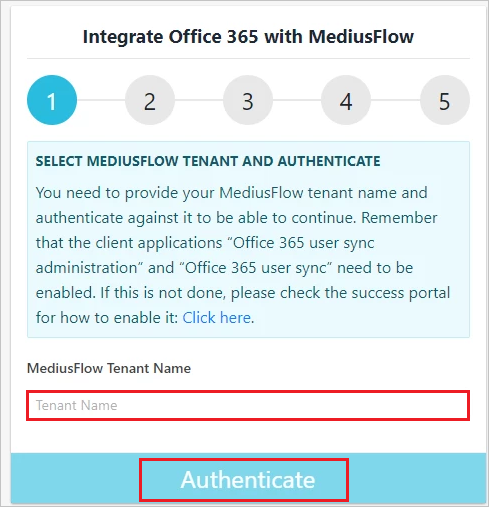
Verify the connection with MediusFlow.
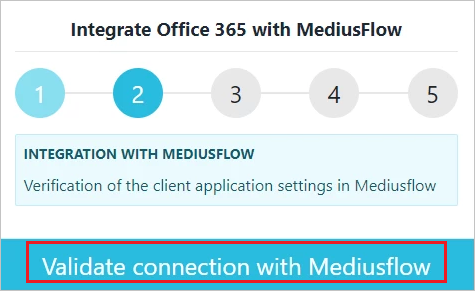
Provide the Microsoft Entra tenant ID.
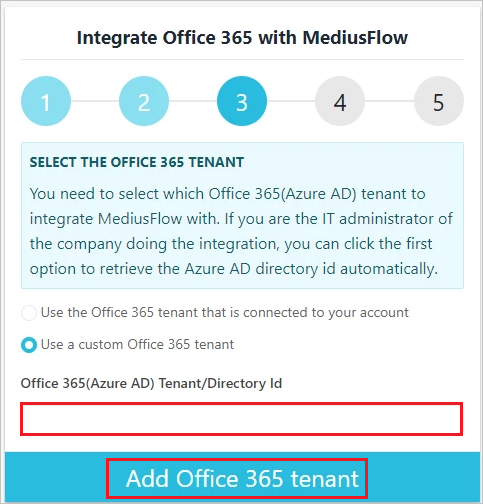
You can read more in the FAQ on how to find it.
Save the configuration.
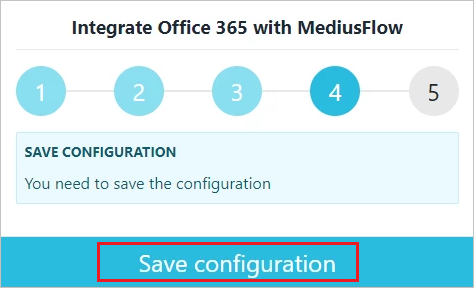
Select user provisioning and click OK.
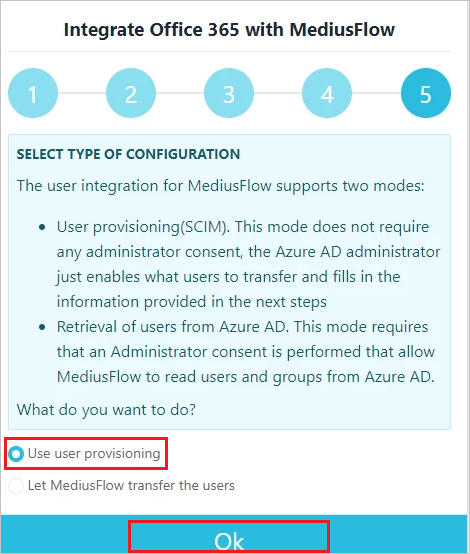
Click on Generate Secret Key. Copy and save this value.This value will be entered in the Secret Token field in the Provisioning tab of your MediusFLow application.
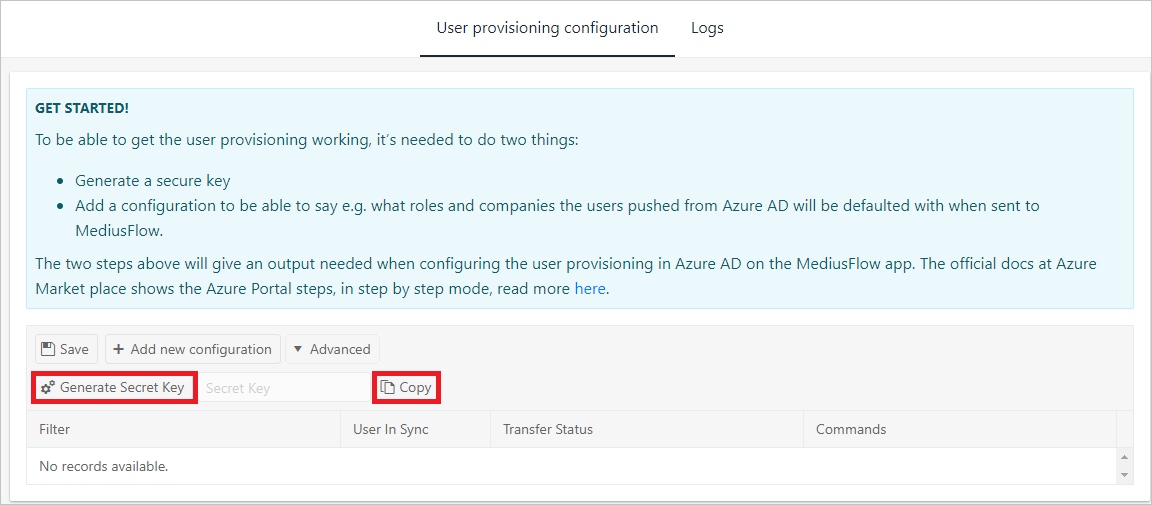
Click on OK.
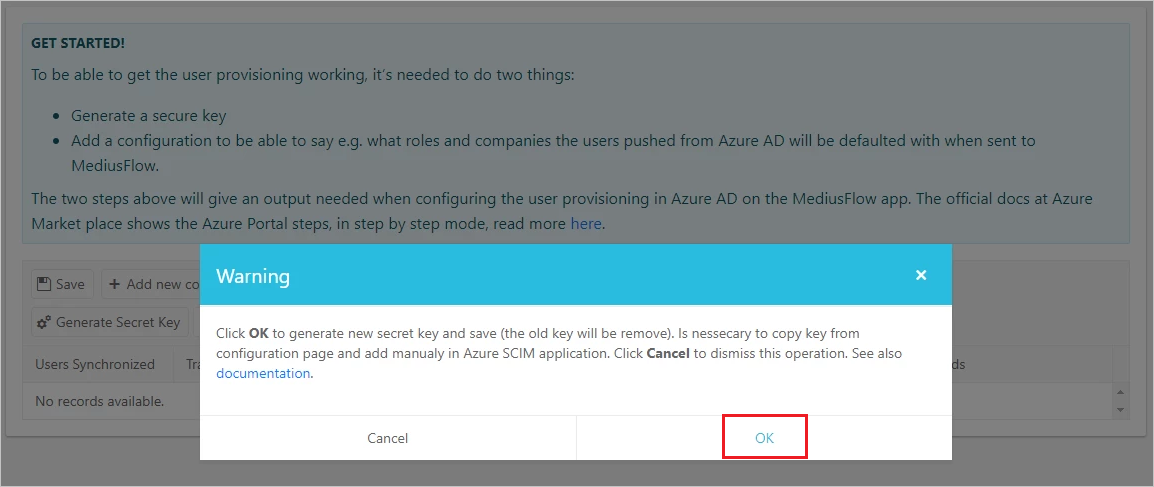
To get the users imported with a pre-defined set of roles, companies and other general configurations in MediusFlow, you will need to configure it first. Start by adding the configuration by clicking on Add new configuration.
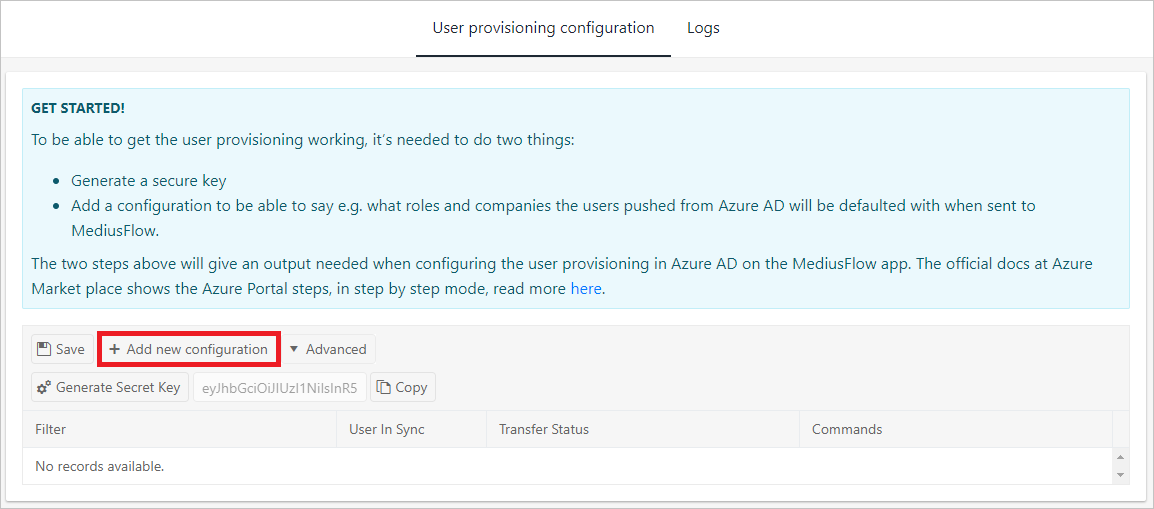
Provide the default settings for the users. In this view, it is possible to set the default attribute. If the standard settings are ok, it is enough to provide just a valid company name. Since these configuration settings are fetched from Mediusflow, they need to be configured first. For more information see the Prerequisites section of this article.
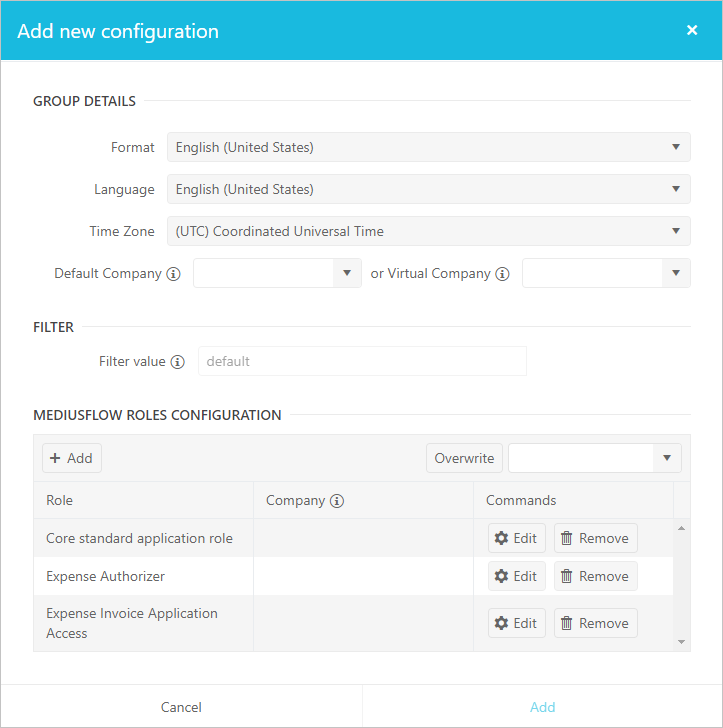
Click on Save to save the user configuration.

To get the user provisioning link click on Copy SCIM Link. Copy and save this value. This value is entered in the Tenant URL field in the Provisioning tab of your MediusFLow application.

Step 3: Add MediusFlow from the Microsoft Entra application gallery
Add MediusFlow from the Microsoft Entra application gallery to start managing provisioning to MediusFlow. If you have previously setup MediusFlow for SSO, you can use the same application. However it is recommended that you create a separate app when testing out the integration initially. Learn more about adding an application from the gallery here.
Step 4: Define who will be in scope for provisioning
The Microsoft Entra provisioning service allows you to scope who will be provisioned based on assignment to the application and or based on attributes of the user / group. If you choose to scope who will be provisioned to your app based on assignment, you can use the following steps to assign users and groups to the application. If you choose to scope who will be provisioned based solely on attributes of the user or group, you can use a scoping filter as described here.
Start small. Test with a small set of users and groups before rolling out to everyone. When scope for provisioning is set to assigned users and groups, you can control this by assigning one or two users or groups to the app. When scope is set to all users and groups, you can specify an attribute based scoping filter.
If you need additional roles, you can update the application manifest to add new roles.
Step 5: Configure automatic user provisioning to MediusFlow
This section guides you through the steps to configure the Microsoft Entra provisioning service to create, update, and disable users and/or groups in TestApp based on user and/or group assignments in Microsoft Entra ID.
To configure automatic user provisioning for MediusFlow in Microsoft Entra ID:
Sign in to the Microsoft Entra admin center as at least a Cloud Application Administrator.
Browse to Identity > Applications > Enterprise applications
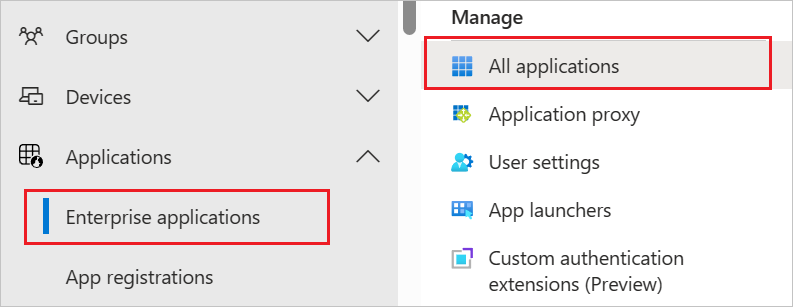
In the applications list, select MediusFlow.
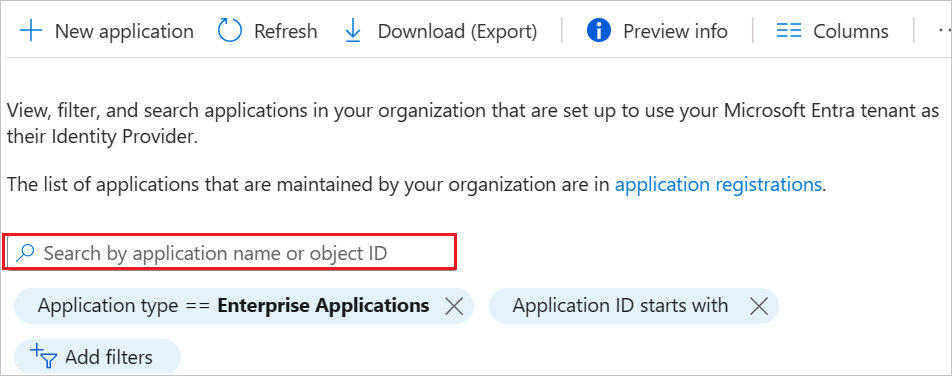
Select the Provisioning tab.

Set the Provisioning Mode to Automatic.

Under the Admin Credentials section, input the tenant URL value retrieved earlier in Tenant URL. Input the secret Token value retrieved earlier in Secret Token. Click Test Connection to ensure Microsoft Entra ID can connect to MediusFlow. If the connection fails, ensure your MediusFlow account has Admin permissions and try again.

In the Notification Email field, enter the email address of a person or group who should receive the provisioning error notifications and select the Send an email notification when a failure occurs check box.

Select Save.
Under the Mappings section, select Synchronize Microsoft Entra users to MediusFlow.
Review the user attributes that are synchronized from Microsoft Entra ID to MediusFlow in the Attribute-Mapping section. The attributes selected as Matching properties are used to match the user accounts in MediusFlow for update operations. If you choose to change the matching target attribute, you will need to ensure that the MediusFlow API supports filtering users based on that attribute. Select the Save button to commit any changes.
Attribute Type Supported for filtering userName String ✓ emails[type eq "work"].value String name.displayName String active Boolean name.givenName String name.familyName String name.formatted String externalId String urn:ietf:params:scim:schemas:extension:enterprise:2.0:User:manager Reference urn:ietf:params:scim:schemas:extension:medius:2.0:User:configurationFilter String urn:ietf:params:scim:schemas:extension:medius:2.0:User:identityProvider String urn:ietf:params:scim:schemas:extension:medius:2.0:User:nameIdentifier String urn:ietf:params:scim:schemas:extension:medius:2.0:User:customFieldText1 String urn:ietf:params:scim:schemas:extension:medius:2.0:User:customFieldText2 String urn:ietf:params:scim:schemas:extension:medius:2.0:User:customFieldText3 String urn:ietf:params:scim:schemas:extension:medius:2.0:User:customFieldText4 String urn:ietf:params:scim:schemas:extension:medius:2.0:User:customFieldText5 String Under the Mappings section, select Synchronize Microsoft Entra groups to MediusFlow.
Review the group attributes that are synchronized from Microsoft Entra ID to MediusFlow in the Attribute-Mapping section. The attributes selected as Matching properties are used to match the groups in MediusFlow for update operations. Select the Save button to commit any changes.
Attribute Type displayName String externalID String members Reference To configure scoping filters, refer to the following instructions provided in the Scoping filter tutorial.
To enable the Microsoft Entra provisioning service for MediusFlow, change the Provisioning Status to On in the Settings section.

Define the users and/or groups that you would like to provision to MediusFlow by choosing the desired values in Scope in the Settings section.

When you are ready to provision, click Save.

This operation starts the initial synchronization cycle of all users and groups defined in Scope in the Settings section. The initial cycle takes longer to perform than subsequent cycles, which occur approximately every 40 minutes as long as the Microsoft Entra provisioning service is running.
Step 6: Monitor your deployment
Once you've configured provisioning, use the following resources to monitor your deployment:
- Use the provisioning logs to determine which users have been provisioned successfully or unsuccessfully
- Check the progress bar to see the status of the provisioning cycle and how close it is to completion
- If the provisioning configuration seems to be in an unhealthy state, the application will go into quarantine. Learn more about quarantine states here.
Change log
- 01/21/2021 - Custom extension attributes configurationFilter, identityProvider, nameIdentifier, customFieldText1, customFieldText2, customFieldText3, customFieldText3 and customFieldText5 has been added.
Additional resources
- Managing user account provisioning for Enterprise Apps
- What is application access and single sign-on with Microsoft Entra ID?